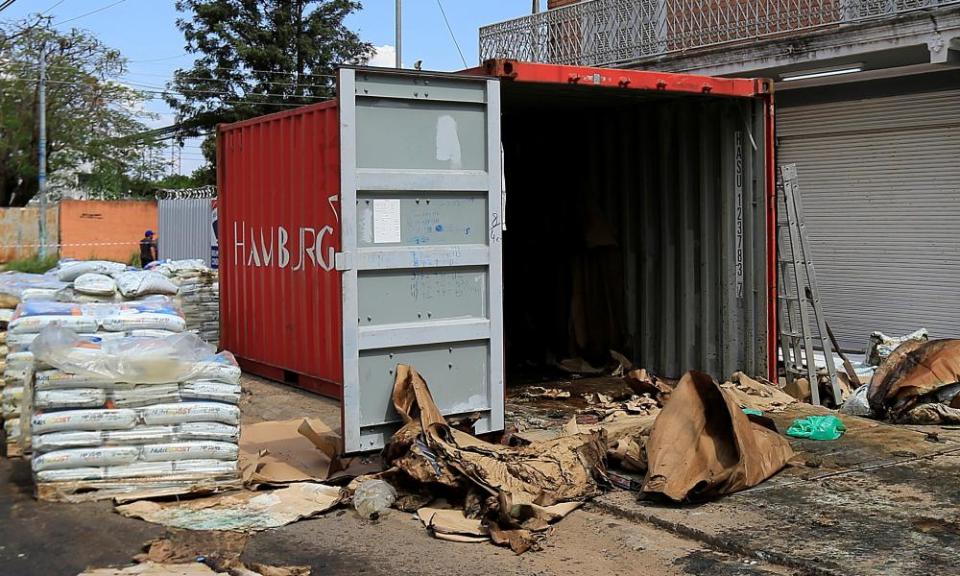Seven migrants boarded a container for Milan. Months later their bodies were discovered
When seven North African men climbed into a shipping container in a railway yard in the Serbian town of Šid this July, they hoped that they would emerge a few days later in Milan.
Related: Paraguay authorities find at least seven bodies in fertilizer shipment
Instead, the container was transferred on to a ship at a Croatian port, before passing through Egypt, Spain and across the Atlantic Ocean to Argentina, where it was taken upriver to Asunción, the landlocked capital of Paraguay.
The men – squeezed in the tiny space between the cargo and the container’s roof – did not survive. Their bodies were eventually discovered on 23 October, four months after they entered the metal box.
“We imagine that their destination wasn’t South America, as they would never have been able to survive the journey,” said Marcelo Saldívar, a public prosecutor in Asunción, pointing to the tiny amount of food supplies in the container.

The seven men’s tragic voyage underscores the extraordinary risks being taken by migrants and refugees endeavouring to reach the EU. Human rights organisations say that people are pushed to take ever more hazardous routes to avoid fierce violence from security forces in Balkan states.
Attempts to identify the men and determine their cause of death have been hampered by the bodies’ advanced state of decomposition, which forensic staff said could have been accelerated by the fertiliser.
But images of identification cards found in the container quickly circulated online. And back in Serbia, friends of the men came forward, including Smail Maouch, an Algerian man currently in a refugee camp in Šid.
Maouch said he had lived at the camp for over a year with several of the men, who he identified as Zugar Hamza and Sidahmed Ouherher from Algeria, Ahmed Belmiloudi, Said Rachir, Rachid Sanhaji and Mohamed Hadoun from Morocco, and Yessa Aymen from Egypt.
“We were like brothers,” he told the Guardian.
Every day, thousands of people, mainly from south Asia, the Middle East and north Africa, attempt to cross the Balkans to reach Europe. It is a long and arduous route, which crosses mountains and snow-covered forests with virtually no facilities for migrants.
The journey can take months and is characterized by brutal violence and illegal pushbacks perpetrated by border police in Serbia, Bosnia and Croatia. But for migrants, it offers the chance of arriving in the heart of Europe without dangerous sea crossings from Turkey to Greece.
And for North Africans, who are often considered economic migrants, this route is often the only alternative – given that authorities in Greece and Italy routinely return migrants straight back to their home countries.
Maouch said Hamza had contacted him by phone in July to ask him to join him on the the 900km journey to Milan. But Maouch was in Bosnia after a previous unsuccessful attempt to cross Croatia.
“When they disappeared for days, I knew that they wouldn’t reach Europe,” he said. “I was sure they were dead.”
The train the men boarded did not head to Milan via the Croatian capital Zagreb as expected. Instead, it went to the Croatian port of Rijeka where the container was transferred on to a ship.
Maouch said that this was not the first time that migrants entering containers in Šid had unwittingly been taken to the port. In other cases, however, they had managed to raise the alarm before it was too late.
Croatia’s customs administration said it had no comment regarding the event. Paraguayan authorities have suggested the men may have suffocated soon after entering the container, explaining why they may not have called for help.
“Unfortunately, it’s not new for people to lose their lives on this route,” said Jack Sapoch of the NGO No Name Kitchen which works in Šid as a member of the Border Violence Monitoring Network.
“There is pervasive violence along the borders that pushes people to take more dangerous ways to try and avoid that violence, such as in this case,” he said.
The final leg of the journey, from Bosnia to Croatia, is the most perilous and gruelling part of the route, given the systematic violence carried out by squadrons of Croatian police who patrol the EU’s longest external border armed with truncheons, pistols and night vision goggles.
The Croatian government has continuously denied accusations of abuse, but the EU ombudsman has launched an inquiry into the European Commission’s alleged failure to guarantee the rights of migrants and refugees in Croatia.
Maouch said he had experienced violence on several attempts to cross the Balkans and said that his seven friends had all had similar experiences before their ill-fated journey.
“I was tortured a lot,” he said. “They burned my clothes and my phone more than once.”
Ouherher’s mother appeared on Algerian television and appealed for the repatriation of the men’s remains. Paraguayan authorities continue to work to provide official confirmation of the identities of the bodies.
Two men, who reportedly closed the seven in the container, have been arrested in Serbia on charges of human trafficking.
Now, far from the fierce heat of the Paraguayan summer, Sapoch said that Serbia’s impending winter will push more people to take dire risks in a rush to cross the Balkans before conditions become too harsh.
The final message that Ouherher sent to his family hinted at the harsh conditions he faced: “There are people that aren’t nice at all. God help me. God helped me find wifi and I was able to call you. They brought us to Serbia. My head is going to explode. All that I risked has been in vain.”

